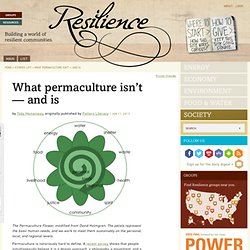

Permaculture: The Big Rock Candy Mountain. Let me say at the start that I am an old hand with some claim to know what I’m talking about.

I have a background in the life sciences, and for many years worked professionally in horticulture. I have been in the ‘alternative’ tribe all my life. I am acquainted with the permaculture literature, did the 72-hour course nearly 20 years ago, contributed to the Permaculture Teachers Handbook, and personally know many of the luminaries of the movement. However I very rarely use the word ‘permaculture’ because it is too vague a term, and leads to misunderstandings. Everyone and their dog seems to have a different take on it. When I first encountered permaculture, I assumed it had some new principles to suggest, was eager to test them, discard the lemons, and move on. Such an idea for water management had been explored and developed by P.A.
This kind of approach made tremendous sense to me. Another idea that rang a bell was laying out the geometry of a garden for functional efficiency. What permaculture isn’t — and is. The Permaculture Flower, modified from David Holmgren.

The petals represent the basic human needs, and we work to meet them sustainably on the personal, local, and regional levels. Permaculture is notoriously hard to define. A recent survey shows that people simultaneously believe it is a design approach, a philosophy, a movement, and a set of practices. This broad and contradiction-laden brush doesn’t just make permaculture hard to describe. It can be off-putting, too. Let’s say you first encounter permaculture as a potent method of food production and are just starting to grasp that it is more than that, when someone tells you that it also includes goddess spirituality, and anti-GMO activism, and barefoot living. I’m going to argue here that the most accurate and least muddled way to think of permaculture is as a design approach, and that we are often misdirected by the fact that it fits into a larger philosophy and movement which it supports. Humans are a problem-solving species. 5 Easy to Grow Mosquito-Repelling Plants.
As the outdoor season approaches, many homeowners and outdoor enthusiasts look for ways to control mosquitoes.

With all the publicity about the West Nile virus, mosquito repelling products are gaining in popularity. But many commercial insect repellents contain from 5% to 25% DEET. There are concerns about the potential toxic effects of DEET, especially when used by children. Children who absorb high amounts of DEET through insect repellents have developed seizures, slurred speech, hypotension and bradycardia. There are new DEET-free mosquito repellents on the market today which offer some relief to those venturing outdoors in mosquito season. Here are five of the most effective mosquito repelling plants which are easy to grow in most regions of the US: What is Permaculture - Part 1: Ethics. Permaculture is primarily a thinking tool for designing low carbon, highly productive systems but its influence can be very pervasive!

What can start as a journey towards living a more ecologically balanced lifestyle can go far deeper, even transforming our worldview and radically altering behaviour. This is the inspirational nature of permaculture, it is a means of connecting each of us more deeply to nature’s patterns and wisdom and of practically applying that understanding in our daily lives. The discipline of permaculture design is based on observing what makes natural systems endure; establishing simple yet effective principles, and using them to mirror nature in whatever we choose to design. This can be gardens, farms, buildings, woodlands, communities, businesses, even towns and cities. Permaculture is essentially about creating beneficial relationships between individual elements and making sure energy is captured in, rather than lost from, a system.
Earth Care People Care. Permaculture. Ask Nature - the Biomimicry Design Portal: biomimetics, architecture, biology, innovation inspired by nature, industrial design - Ask Nature - the Biomimicry Design Portal: biomimetics, architecture, biology, innovation inspired by nature, industrial desi. Permaculture Association.